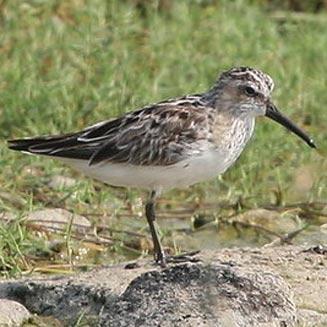|
Limicola falcinellus
(Broad-billed sandpiper)
Breëbekstrandloper [Afrikaans]; Breedbekstrandloper
[Dutch]; Bécasseau falcinelle [French]; Sumpfläufer [German];
Pilrito-de-bico-largo [Portuguese]
Life
> Eukaryotes >
Opisthokonta
> Metazoa (animals) >
Bilateria >
Deuterostomia > Chordata >
Craniata > Vertebrata (vertebrates) > Gnathostomata (jawed
vertebrates) > Teleostomi (teleost fish) > Osteichthyes (bony fish) > Class:
Sarcopterygii (lobe-finned
fish) > Stegocephalia (terrestrial
vertebrates) > Tetrapoda
(four-legged vertebrates) > Reptiliomorpha > Amniota >
Reptilia (reptiles) >
Romeriida > Diapsida > Archosauromorpha > Archosauria >
Dinosauria
(dinosaurs) > Saurischia > Theropoda (bipedal predatory dinosaurs) >
Coelurosauria > Maniraptora > Aves
(birds) >
Order: Charadriiformes > Family: Scolopacidae
 |
|
|
Broad-billed sandpiper in non-breeding plumage,
India. [photo Arpit
Deomurari ©] |
|
Distribution and habitat
Breeds in patches in Scandinavia and Siberia; the latter
population has non-breeding grounds in South-East Asia and Australia while the
former heads south to India, Sri Lanka and to a much lesser extent Africa. It is
a rare vagrant to southern Africa, with approximately approximately records in
Zimbabwe and along the coast of Namibia, southern Mozambique and South Africa.
It generally prefers muddy estuaries and pools near the sea as well as sewage
works and salt pans.
Movements and migrations
All southern African sightings are in the
period from September-January, especially November.
Food
It specialises in feeding on polychaete worms, foraging by
walking fairly quickly through mud, pecking left and right before occasionally
probing more deeply to extract prey.
Threats
Not threatened.
References
-
Hockey PAR, Dean WRJ and Ryan PG 2005. Roberts
- Birds of southern Africa, VIIth ed. The Trustees of the John Voelcker
Bird Book Fund, Cape Town.
|
